
Topic 1
Topic 1
Units, Trigonometry, and Vectors
QUICK QUIZZES
1.1 Choice (c). The largest possible magnitude of the resultant occurs when the two vectors are in the same direction. In this case, the magnitude of the resultant is the sum of the magnitudes of and : R = A + B = 20 units. The smallest possible magnitude of the resultant occurs when the two vectors are in opposite directions, and the magnitude is the difference of the magnitudes of and : R = | A B | = 4 units.
1.2 Vector x-component y-component
1.3 Vector . The range of the inverse tangent function includes only the first and fourth quadrants (i.e., angles in the range
/2
/2). Only
© 2025 Cengage Learning. All Rights Reserved. May not be scanned, copied or duplicated, or posted to a publicly accessible website, in whole or in part.
vector has an orientation in this range.
ANSWERS TO EVEN NUMBERED CONCEPTUAL QUESTIONS
1.2 Atomic clocks are based on the electromagnetic waves that atoms emit. Also, pulsars are highly regular astronomical clocks.
1.4 (a) 0.5 lb ≈ 0.25 kg or 10 1 kg (b) 4 lb ≈ 0.25 kg or 100 kg (c) 4 000 lb ≈ 2 000 kg or 103 kg
1.6 Let us assume the atoms are solid spheres of diameter 10 10 m. Then, the volume of each atom is of the order of 10 30 m 3. (More precisely, volume = 4pr 3 / 3.) Therefore, since 1 cm3 = 10 6 m 3, the number of atoms in the 1 cm3 solid is on the order of 10 6 / 10 30 = 1024 atoms. A more precise calculation would require knowledge of the density of the solid and the mass of each atom. However, our estimate agrees with the more precise calculation to within a factor of 10.
1.8 Choice (d). For an angle from 0 to 360, the sine and cosine functions take the values -1 £ sinq£1 and -1 £ cosq£1
1.10 In the metric system, units differ by powers of ten, so it’s very easy
© 2025 Cengage Learning. All Rights Reserved. May not be scanned, copied or duplicated, or posted to a publicly accessible website, in whole or in part.
and accurate to convert from one unit to another.
1.12 Both answers (d) and (e) could be physically meaningful. Answers (a), (b), and (c) must be meaningless since quantities can be added or subtracted only if they have the same dimensions.
1.14 The correct answer is (a). The second measurement is more precise but, given the number of reported significant figures, each measurement is consistent with the other.
1.16 The components of a vector will be equal in magnitude if the vector lies at a 45 angle with the two axes along which the components lie.
ANSWERS TO EVEN NUMBERED PROBLEMS
1.2 (a) L / T2 (b) L
1.4 All three equations are dimensionally incorrect. 1.6 (a)
Topic 1 © 2025 Cengage Learning. All Rights Reserved. May not be scanned, copied or duplicated, or posted to a publicly accessible website, in whole or in part.
Topic 1
(d) 6.0088 km
1.14 10.6 kmL
1.16 9.2 nms
1.18 2.9 102 m 3 = 2.9 108 cm 3
1.20 2.57 106 m 3
1.22 (a) 797 (b) 1.1 (c) 17.66
1.24 58
1.26 (a) 22.6 (b) 22.7 (c) 22.6 is more reliable
1.28 (a) 3.00 108 m/s (b) 2.997 9 108 m/s (c) 2.997 925 108 m/s
1.30 (a) 346 m2 13 m3 (b) 66.0 m 1.3 m
1.32 ~108 steps
1.34 ~108 people with colds on any given day
1.36 (a) 4.2 10 18 m 3 (b) ~10 1 m 3 (c) ~1016 cells 1.38 10 14 kg
1.40 2.2 m 1.42 8.1 cm 1.44 Ds = r1 2 +r2 2 - 2r1r2 cos(q1 -q2)
© 2025 Cengage Learning. All Rights Reserved. May not be scanned, copied or duplicated, or posted to a publicly accessible website, in whole or in part.
Topic 1
1.46 2.33 m
1.48 (a) 1.50 m (b) 2.60 m
1.50 8.60 m
1.52 1.44 103 m
1.54 (a) 6.1 units at = +113 (b) 15 units at = +23
1.56 (a) 484 km (b) 18.1 N of W
(c) Because of Earth’s curvature, the plane does not follow straight lines.
1.58
1.60 (a) 13.4 m (b) 19.9 m
1.62 1.31 km northward, 2.81 km eastward
1.64 (a) 10.0 m (b) 15.7 m (c) 0
1.66 42.7 yards
1.68 225 km at 83.9 N of E
1.70 (a) 185 N at 77.8 from the x-axis (b) 185 N at 258 from the x-axis
1.72 (a) 1.609 km/h (b) 88 km/h (c) 16 km/h
1.74 (a) 7.14 10 2 gal/s (b) 2.70 10 4 m 3/s (c) 1.03 h
© 2025 Cengage Learning. All Rights Reserved. May not be scanned, copied or duplicated, or posted to a publicly accessible website, in whole or in part.
Topic 1
1.76 (a) A2/A1 = 4 (b) V2/V1 = 8
1.78 (a) 600 yr (b) 7 104 times
1.80 1 106
PROBLEM SOLUTIONS
1.1 Substituting dimensions into the given equation T = 2p ℓ/ g , and recognizing that 2is a dimensionless constant, we have T[ ] = ℓ[ ] g[ ] or T = L L/ T2 = T2 = T
Thus, the dimensions are consistent
1.2 (a) From x = Bt2, we find that B = x/t2 Thus, B has units of [B] = [x]/[t2] = L/T2 (b) If x = A sin (2ft), then [A] = [x]/[sin (2ft)]
But the sine of an angle is a dimensionless ratio.
Therefore, [A] = [x] = L.
1.3 (a) The units of volume, area, and height are: [V] = L3 , [A] = L2, and [h] = L
We then observe that L3 = L2 L or [V] = [A][h] Thus, the equation V
© 2025 Cengage Learning. All Rights Reserved. May not be scanned, copied or duplicated, or posted to a publicly accessible website, in whole or in part.
Topic 1
= Ah is dimensionally correct
(b) Vcylinder = pR2h = pR2 ( )h = Ah, where A = pR2 .
1.4 (a) In the equation , while mgh
Thus, the equation is dimensionally incorrect
(b) In , but [at2] = [a][t2] = L T2
Hence, this equation is dimensionally incorrect.
(c) In the equation ma = v 2, we see that [
while . Therefore, this equation is also dimensionally incorrect.
1.5 From the universal gravitation law, the constant G is G = Fr2/Mm. Its units are then
1.6 (a) Solving KE = p 2/2m for the momentum, p, gives p = 2m KE( )
where the numeral 2 is a dimensionless constant. Dimensional
© 2025 Cengage Learning. All Rights Reserved. May not be scanned, copied or duplicated, or posted to a publicly accessible website, in whole or in part.
analysis gives the units of momentum as: p[ ] = m[ ] KE[ ] = M M×L2 / T2 ( ) = M2 ×L2 / T
Therefore, in the SI system, the units of momentum are kg (m/s)
(b) Note that the units of force are kg ms 2 or [F] = ML/T2. Then,
observe that [F][t] = (ML/T2)T = M(L/T) = [p]
From this, it follows that force multiplied by time is proportional to momentum: Ft = p. (See the impulse-momentum theorem in Topic 6, which says that a constant force F multiplied by a duration of time t equals the change in momentum, p.)
1.7 Use the conversion factor 1 cubitus = 0.445 m to find the basketball player’s height:
1.8 Use the conversion factor 1 m = 3.281 ft to find 1.9
1 © 2025 Cengage Learning. All Rights Reserved. May not be scanned, copied or duplicated, or posted to a publicly accessible website, in whole or in part. 8
Topic 1
The answer is limited to one significant figure because of the accuracy to which the conversion from fathoms to feet is given.
1.10 giving v = 3.09 cm/s 1.11

1.12 Use the conversion factors 1 km = 103 m, 1 m = 102 cm, 1 mi = 1.609 km = 1000 m, 12 in. = 1 ft, and 1 in. = 2.54 cm to find:
(a)
© 2025 Cengage Learning. All Rights Reserved. May not be scanned, copied or duplicated, or posted to a publicly accessible website, in whole or in part.
Commented [TE1]: CPM: The answer for question 1.12 is given in 1.22 in the Restore PDF. We have matched the question and its number with Edited MS and set as 1.12. Hope this is correct.
Topic 1
53
1971412in.2.54cm ft=19714ft6.008810cm=6.008810m=6.0088km 1ft1in.
In (a), the answer is limited to three significant figures because of the accuracy of the original data value, 348 miles. In (b), (c), and (d), the answers are limited to four significant figures because of the accuracy to which the kilometers-to-feet conversion factor is given.
1.13 Use the conversion factors 1.00 league = 3.00 mi, 1 mile = 1609 m, and 1 hr = 3600 s to find m1mi1league3600s 30.0m/s=30.022.4leagues/ s1609m3.00mi1hrhr

1.14 1.15 (a)


© 2025 Cengage Learning. All Rights Reserved. May not be scanned, copied or duplicated, or posted to a publicly accessible website, in whole or in part.
Commented [TE2]: CPM: The answer for question 1.13 is given in 1.23 in the Restore PDF. We have matched the question and its number with Edited MS and set as 1.13. Hope this is correct.
Topic 1

This means that the proteins are assembled at a rate of many layers of atoms each second!




1.21 Volume of cube = L3 = 1 quart (Where L = length of one side of the cube.)
2025 Cengage Learning. All Rights Reserved. May not be scanned, copied or duplicated, or posted to a publicly accessible website, in whole or in part.

1.22 (a) The sum is rounded to 797 because 756 in the terms to be added has no positions beyond the decimal.
(b) 0.003 2 356.3 = (3.2 10 3) 356.3 = 1.140 16 must be rounded to 1.1 because 3.2 10 3 has only two significant figures.
(c) 5.620 must be rounded to 17.66 because 5.620 has only four significant figures.
1.23 The rectangular airstrip’s area is its length times its width. The width contains four significant figures while the length contains two.
Therefore the answer should be rounded to two significant figures:
A = LW = 210 m ( ) 32.30 m ( ) A = 6.8 ´103 m 2 (rounded to two significant figures)
1.24 The number 15 contains no significant figures after the decimal, so the sum should be rounded to no digits after the decimal:
21.4 +15 +17.17 + 4.003 = 58 (rounded to no digits past the decimal)
1.25 The area A of the rectangular room is A = LW = (9.72 m)(5.3 m) = 52 m 2 .
1.26 (a) Computing 8 ( )3 without rounding the intermediate result
© 2025 Cengage Learning. All Rights Reserved. May not be scanned, copied or duplicated, or posted to a publicly accessible website, in whole or in part.
Topic 1
yields 8 ( )3 = 22.6 to three significant figures.
(b) Rounding the intermediate result to three significant figures yields 8 = 2.8284 ® 2.83 Then, we obtain 8 ( )3 = 2.83( )3 = 22.7 to three significant figures.
(c) The answer 22.6 is more reliable because rounding in part (b) was carried out too soon.
1.27 (a) 78.9 ± 0.2 has 3 significant figures with the uncertainty in the tenths position.
(b) 3.788 109 has 4 significant figures 4 significant figures
(c) 246 10 6 has 3 significant figures
(d) 0.003 2 = 3.2 10 3 has 2 significant figures. The two zeros were originally included only to position the decimal.
1.28 c = 2.997 924 58 108 m/s
(a) Rounded to 3 significant figures: c = 3.00 108 ms
(b) Rounded to 5 significant figures: c = 2.997 9 108 ms
(c) Rounded to 7 significant figures: c = 2.997 925 108 ms
1.29 For a length of L = (2.0 ± 0.2) m and a width of W = (1.5 ± 0.1) m:
© 2025 Cengage Learning. All Rights Reserved. May not be scanned, copied or duplicated, or posted to a publicly accessible website, in whole or in part.
(a) The maximum value for the area, A = LW, is found using the maximum values of L and W:
Amax = (2.2 m)(1.6 m) = 3.52 m2
The minimum area is found using the minimum values of L and W: Amin = (1.8 m)(1.4 m) = 2.52 m2
The area using numbers in the middle of the uncertainty range is Amiddle = LW = (2.0 m)(1.5 m) = 3.0 m2
An uncertainty of about ± 0.5 m2 is needed to cover the range from Amax to Amin so that A = 3.0 ± 0.5 ( ) m 2
(b) The perimeter of a rectangle is P = 2L + 2W = 2(L + W). As before, the maximum, minimum, and middle values are:
= 2(2.2 m + 1.6 m) = 7.6 m
min = 2(1.8 m + 1.4 m) = 6.4 m Pmiddle = 2(2.0 m + 1.5 m) = 7.0 m
An uncertainty of ±0.6 is needed to cover the range from Pmax to Pmin so that P = 7.0 ± 0.6 ( ) m
1 © 2025 Cengage Learning. All Rights Reserved. May not be scanned, copied or duplicated, or posted to a publicly accessible website, in whole or in part.
(0.2
2]. Recognize that the last term in the brackets is insignificant in comparison to the other two. Thus, we have
1.31 The least accurate dimension of the box has two significant figures.
Thus, the volume (product of the three dimensions) will contain only two significant figures.
1.32 We estimate that the length of a step for an average person is about 18 inches, or roughly 0.5 m.
Then, an estimate for the number of steps required to travel a distance equal to the circumference of the Earth would be
or N 103 steps
1.33 We assume an average respiration rate of about 10 breathsminute and a typical life span of 70 years. Then, an estimate of the number of breaths an average person would take in a lifetime is
or n ~ 108 breaths
Topic 1 © 2025 Cengage Learning. All Rights Reserved. May not be scanned, copied or duplicated, or posted to a publicly accessible website, in whole or in part.
1.34 We assume that the average person catches a cold twice a year and is sick an average of 7 days (or 1 week) each time. Thus, on average, each person is sick for 2 weeks out of each year (52 weeks). The probability that a particular person will be sick at any given time equals the percentage of time that person is sick, or probability of sickness = 2 weeks 52 weeks = 1 26
The population of the Earth is approximately 7 billion. The number of people expected to have a cold on any given day is then
Number sick = (population)(probability of sickness) = (7 ´109) 1 26 æ è ç ö ø ÷ = 3´108 or 108
1.35 Earth’s current population is about 7.3 billion people. If six people can stand within a 1-m2 area, the total area required to fit all 7.3 billion people is:
The required percentage of the habitable part of Earth’s surface is:
Topic 1 © 2025 Cengage Learning. All Rights Reserved. May not be scanned, copied or duplicated, or posted to a publicly accessible website, in whole or in part.
(b) Consider your body to be a cylinder having a radius of about 6
inches (or 0.15 m) and a height of about 1.5 meters. Then, its volume is
(c) The estimate of the number of cells in the body is then
1.37 A reasonable guess for the diameter of a tire might be 3 ft, with a circumference (C = 2r = D = distance traveled per revolution) of about 9 ft. Thus, the total number of revolutions the tire might make is n = totaldistance traveled distanceper revolution = (50000 mi)(5 280 ft/mi) 9
1.38 An average body mass is about 70 kg and, taking the center of the given range, approximately 2% or 1.4 kg of this mass is made of microorganisms. If there are 100 trillion microorganisms in a human body, the average mass of a microorganism is about mmicroorganism » 1.4 kg 100 ´1012 microorganisms » 1´10-14 kg
1.39 The x coordinate is found as x = r cos = (2.5 m)cos 35 = 2.0 m and the y coordinate y = r sin = (2.5 m)sin 35 = 1.4 m
1.40 The x distance out to the fly is 2.0 m and the y distance up to the fly is
© 2025 Cengage Learning. All Rights Reserved. May not be scanned, copied or duplicated, or posted to a publicly accessible website, in whole or in part.
Topic 1
1.0 m. Thus, we can use the Pythagorean theorem to find the distance from the origin to the fly as d = x 2 + y 2 = (2.0 m)2 + (1.0 m)2 = 2.2 m
1.41 The distance from the origin to the fly is r in polar coordinates, and this was found to be 2.2 m in Problem 40. The angle is the angle between r and the horizontal reference line (the x axis in this case). Thus, the angle can be found as tanq= y x = 1.0 m 2.0 m = 0.50 and = tan 1 (0.50) = 27
The polar coordinates are r = 2.2 m and = 27
1.42 The x distance between the two points is |x| = |x2 x1| = | 3.0 cm
5.0 cm|= 8.0 cm and the y distance between them is |y| = |y2 y1| = |
3.0 cm 4.0 cm| = 1.0 cm. The distance between them is found from the Pythagorean theorem: d = Dx 2 + Dy 2 = (8.0 cm)2 + (1.0 cm)2 = 65cm2 = 8.1cm
1.43 Refer to the Figure given in the solution to Problem 1.44 below. The Cartesian coordinates for the two given points are:
x1 = r1 cos 1 = (2.00 m) cos 50.0 = 1.29 m y1 = r1 sin 1 = (2.00 m) sin 50.0 = 1.53 m
© 2025 Cengage Learning. All Rights Reserved. May not be scanned, copied or duplicated, or posted to a publicly accessible website, in whole or in part.
x2 = r2 cos 2 = (5.00 m) cos ( 50.0) = 3.21 m
y2 = r2 sin 2 = (5.00 m) sin ( 50.0) = 3.83 m
The distance between the two points is then:
1.44 Consider the Figure shown below. The Cartesian coordinates for the two points are:
Topic 1 © 2025 Cengage Learning. All Rights Reserved. May not be scanned, copied or duplicated, or posted to a publicly accessible website, in whole or in part.

The distance between the two points is the length of the hypotenuse of the shaded triangle and is given by
Applying the identities cos2 + sin2 = 1 and cos 1 cos
2 + sin
1
2 = cos(1 2), this reduces to
1.45 (a) With a = 6.00 m and b being two sides of this right triangle having hypotenuse c = 9.00 m, the Pythagorean theorem gives the unknown side as b = c

(b) tanq= a b = 6.00 m 6.71m = 0.894
(c) sinf= b c = 6.71m 9.00 m = 0.746
1.46 From the diagram, cos(75.0) = d/L
Thus, d = L cos(75.0) = (9.00 m) cos(75.0) = 2.33 m
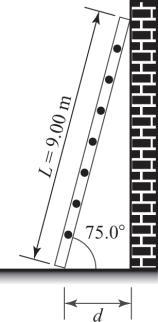
Topic 1 © 2025 Cengage Learning. All Rights Reserved. May not be scanned, copied or duplicated, or posted to a publicly accessible website, in whole or in part.
Topic 1
1.47 The circumference of the fountain is C = 2r, so the radius is r = C 2p = 15.0 m 2p = 2.39 m

Thus, tan(55.0°)= h r = h 2.39 m which gives
h = (2.39 m) tan (55.0) = 3.41 m.
1.48 (a) sinq= oppositeside hypotenuse so, opposite side = (3.00 m) sin (30.0) = 1.50 m (b) cosq= adjacentside hypotenuse so, adjacent side = (3.00 m) cos (30.0) = 2.60 m
1.49 (a) The side opposite = 3.00 (b) The side adjacent to = 3.00 (c) cosq= 4.00 5.00 = 0.800 (d) sinf= 4.00 5.00 = 0.800 (e) tanf= 4.00 3.00 = 1.33
1.50 Using the diagram below, the Pythagorean theorem yields c = (5.00 m)2 + (7.00 m)2 = 8.60 m
© 2025 Cengage Learning. All Rights Reserved. May not be scanned, copied or duplicated, or posted to a publicly accessible website, in whole or in part.
Topic 1

1.51 From the diagram given in Problem 1.50 above, it is seen that tanq= 5.00 7.00 = 0.714 and = tan 1 (0.714) = 35.5
1.52 Use the diagram below to equate two expressions for the mountain’s height (units and significant digits have been suppressed for clarity):
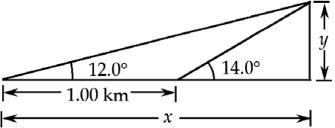
y = (x 1)tan(14.0) = (x)tan(12.0)
Solve for the unknown distance x to find
x -1 ( )tan 14.0° ( ) = xtan 12.0° ( ) x tan14° - tan12° ( ) = tan14°
x = tan14° tan14° - tan12° = 6.78 km
Substitute the known value of x into y = (x)tan(12.0) to find the mountain’s height:
y = xtan 12° ( ) = 6.78 km ( )tan 12° ( ) = 1.44 km = 1.44 ´103 m
1.53 Using the sketch below:
© 2025 Cengage Learning. All Rights Reserved. May not be scanned, copied or duplicated, or posted to a publicly accessible website, in whole or in part.

1.54 (a) Using graphical methods, place the tail of vector at the head of vector . The new vector has a magnitude of 6.1 units at 113 from the positive x-axis. (b) The vector difference is found by placing the negative of vector (a vector of the same magnitude as , but opposite direction) at the head of vector . The resultant vector has magnitude 15 units at 23 from the positive x-axis.

1 © 2025 Cengage Learning. All Rights Reserved. May not be scanned, copied or duplicated, or posted to a publicly accessible website, in whole or in part.
1.55 We are given that . When two vectors are added graphically, the second vector is positioned with its tail at the tip of the first vector. The resultant then runs from the tail of the first vector to the tip of the second vector. In this case, vector will be positioned with its tail at the origin and its tip at the point (0, 29). The resultant is then drawn,
1
starting at the origin (tail of first vector) and going 14 units in the negative y-direction to the point (0, 14). The second vector, , must then start from the tip of at point (0, 29) and end on the tip of at point (0, 14) as shown in the sketch below. From this, it is seen that

1.56 (a) The distance d from A to C is where x = 200 km + (300 km)cos 30.0 = 460 km and y = 0 + (300 km)sin 30.0 = 150 km.

(b)
(c) Because of the curvature of the Earth, the plane doesn't travel
2025 Cengage Learning. All Rights Reserved. May not be scanned, copied or duplicated, or posted to a publicly accessible website, in whole or in part.
along straight lines. Thus, the answer computed above is only approximately correct.
1.57 (a) In your vector diagram, place the tail of vector at the tip of vector . The vector sum, , is then found as shown in the vector diagram and should be
(b) To find the vector difference , form the vector (same magnitude as , opposite direction) and add it to vector as shown in the diagram. You should find that
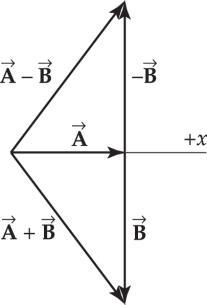
1.58 Find the resultant graphically by placing the tail of at the head of in a scale drawing as shown below. The resultant is the vector drawn from the tail of to the head of to close up the triangle. Measuring the length and orientation of this vector shows
© 2025 Cengage Learning. All Rights Reserved. May not be scanned, copied or duplicated, or posted to a publicly accessible website, in whole or in part.
1

1.59 Your sketch should be drawn to scale, and be similar to that pictured below. The length of and the angle can be measured to find, with use of your scale factor, the magnitude and direction of the resultant displacement. The result should be approximately 421 ft 3 below the horizontal

1.60 (a) The x-component is x = (24.0 m)cos(56.0) = 13.4 m (b) The y-component is y = (24.0 m)sin(56.0) = 19.9 m
1.61 (a) The vector’s magnitude is
2025 Cengage Learning. All Rights Reserved. May not be scanned, copied or duplicated, or posted to a publicly accessible website, in whole or in part.
(b) The vector is in the second quadrant so its direction is
1.62 The person undergoes a displacement
Choose a coordinate system with origin at the starting point, positive x-direction oriented eastward, and positive y-direction oriented northward.
Then the components of her displacement are Ax = A cos = (3.10 km)cos 25.0 = 2.81 km eastward and Ay = A sin = (3.10 km)sin 25.0 = 1.31 km northward
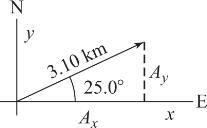
1.63 The x- and y-components of vector are its projections on lines parallel to the x- and y-axes, respectively, as shown in the sketch. The magnitude of these components can be computed using the sine and cosine functions as shown below:
© 2025 Cengage Learning. All Rights Reserved. May not be scanned, copied or duplicated, or posted to a publicly accessible website, in whole or in part.
1.64
1

(a) The skater’s displacement vector, , extends in a straight line from her starting point A to the end point B. When she has coasted half way around a circular path as shown in the sketch below, the displacement vector coincides with the diameter of the circle and has magnitude .

(b) The actual distance skated, s, is one half the circumference of the circular path of radius r. Thus
(c) When the skater skates all the way around the circular path, her end point, B, coincides with the start point, A. Thus, the displacement vector has zero length, or
2025 Cengage Learning. All Rights Reserved. May not be scanned, copied or duplicated, or posted to a publicly accessible website, in whole or in part.
Topic 1
1.65 (a) Her net x (east-west) displacement is 3.00 + 0 + 6.00 = +3.00 blocks, while her net y (north-south) displacement is 0 + 4.00 + 0 = +4.00 blocks. The magnitude of the resultant displacement is and the angle the resultant makes with the x-axis (eastward direction) is
The resultant displacement is then 5.00 blocks at 53.1 N of E
(b) The total distance traveled is 3.00 + 4.00 + 6.00 = 13.0 blocks
1.66 Let the positive x-direction be upfield. After the dribble, sideways run, and upfield pass, the football’s change in position, r , has components
dribblesidewayspass 10.0yd0yd50.0yd40.0yd xxxx =++=−++= and
dribblesidewayspass 0yd15yd0yd15.0yd. yyyy =++=++=
The football’s distance from its original location is then ( ) ( ) ( ) ( ) 222240.0yd15.0yd42.7yd rxy =+=+=
1.67 Ax = 25.0 Ay = 40.0
© 2025 Cengage Learning. All Rights Reserved. May not be scanned, copied or duplicated, or posted to a publicly accessible website, in whole or in part.
Topic 1
From the triangle, we find that , so = 180 = 122
Thus,
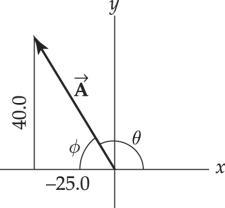
1.68 The displacement from Gwanju to Seoul ( )GS r equals the vector sum of the other two displacements: GSGDDS=+ rrr where GD r is the displacement from Gwanju to Daegu and DS r is the displacement from Daegu to Seoul. Taking the positive x- and y-directions to the right and up as usual, the components of GS r are ( ) ( ) ( )
GSGDDS 155kmcos22.5203kmcos9036.023.9km xxx =+=++= and ( ) ( ) ( )
GSGDDS 155kmsin22.5203kmsin9036.0224km yyy =+=++=
Therefore, the displacement from Gwanju to Seoul has a magnitude of
© 2025 Cengage Learning. All Rights Reserved. May not be scanned, copied or duplicated, or posted to a publicly accessible website, in whole or in part.
Topic 1
( ) ( ) ( ) ( ) 2222 GSGSGS 23.9km224km225km rxy =+=+= in the direction
1.69 After 3.00 h moving at 41.0 km/h, the hurricane is 123 km at 60.0 N of W from the island. In the next 1.50 h, it travels 37.5 km due north. The components of these two displacements are:
Displacement x-component (eastward) y-component (northward)
Therefore, the eye of the hurricane is now
1.70 (a) F1 = 120 N
F1x = (120 N)cos 60.0 = 60.0 N
F1y = (120 N)sin 60.0 = 104 N
© 2025 Cengage Learning. All Rights Reserved. May not be scanned, copied or duplicated, or posted to a publicly accessible website, in whole or in part.
Topic 1
F2 = 80.0 N
F2x = (80 N)cos 75.0 = 20.7 N
F2y = (80.0 N)sin 75.0 = 77.3 N and
The resultant force is
(b) To have zero net force on the mule, the resultant above must be cancelled by a force equal in magnitude and oppositely directed.
Thus, the required force is 185 N at 258 from the x-axis
1.71 The components of the displacements , , and are
ax = a cos 30.0 = +152 km
bx = b cos 110 = 51.3 km
cx = c cos 180 = 190 km and ay = a sin 30.0 = +87.5 km
by = b sin 110 = +141 km
cy = c sin 180 = 0
Thus, Rx = ax + bx + cx = 89.3 km, and Ry = ay + by + cy = 229 km
© 2025 Cengage Learning. All Rights Reserved. May not be scanned, copied or duplicated, or posted to a publicly accessible website, in whole or in part.
so , and City C is 246 km at 21.3 W of N from the starting point.

1.72 (a) 1 mi h = 1 mi h æ è ç
1.609 km 1mi
1.73 The term s has dimensions of L, a has dimensions of LT 2, and t has dimensions of T. Therefore, the equation, s = kam tn with k being dimensionless, has dimensions of L = (LT 2)m (T)n or L1T0 = Lm Tn 2m The powers of L and T must be the same on each side of the equation. Therefore, L1 = Lm and m = 1 Likewise, equating powers of T, we see that n 2m = 0, or n = 2m = 2
© 2025 Cengage Learning. All Rights Reserved. May not be scanned, copied or duplicated, or posted to a publicly accessible website, in whole or in part.
Dimensional analysis cannot determine the value of k, a dimensionless constant.
1.74 (a) The rate of filling in gallons per second is
= 30.0gal
(b) Note that 1m3 = (10
1min
1.75 The volume of paint used is given by V = Ah, where A is the area covered and h is the thickness of the layer. Thus, h = V A = 3.79
1.76 (a) For a sphere, A = 4R2. In this case, the radius of the second sphere is twice that of the first, or R2 = 2R1.
Hence, A2 A1 = 4pR2 2 4pR1 2 = R2 2 R1 2 = (2 R1)2 R1 2 = 4 (b) For a sphere, the volume is V = 4 3 pR3
1 © 2025 Cengage Learning. All Rights Reserved. May not be scanned, copied or duplicated, or posted to a publicly accessible website, in whole or in part.
1.77 Assume N cars each drive an average of D km/yr with a fuel consumption of C L/(100 km). The total fuel consumed each year is then F = NDC and the change in F due to a change in average fuel consumption is ΔF = ND(ΔC). The fuel savings per year is the magnitude of ΔF so that ( ) ( ) 6 10 fuelsaved1yr
1.79 (a) The Sun’s radius is about 6.96 105 km and Earth’s radius is about 6.38 103 km. The number of Earths that could fit inside the Sun, NES, is approximately equal to the ratio of the Sun’s volume to Earth’s volume:
The Sun’s radius is about 102 times Earth’s radius, so its volume (which scales as radius cubed) is about 106 times Earth’s volume.
Approximately a million Earths could fit inside the Sun. (b) Similarly, the Moon’s radius is about 1.74 103 km so that NME, the number of Moons that could fit inside the Earth, is
© 2025 Cengage Learning. All Rights Reserved. May not be scanned, copied or duplicated, or posted to a publicly accessible website, in whole or in part.
Approximately 50 Moons could fit inside the Earth.
1.80 Assume a sneeze lasts about 3 seconds. One day equals 8.64 104 s which can be divided into 8.64/3 104 = 2.88 104 3-second intervals. If each of Earth’s 7.3 billion people sneezes 3 times per day, then 3(7.3 billion) = 21.9 billion sneezes occur each day. The number of sneezes occurring during any particular 3-second interval is then (rounded to 1 significant figure):
21.9 ´109 sneezes/ day 2.88 ´104 (3-sec intervals)/ day » 1´106 sneezes/ (3-sec interval)
During any given 3-second interval, approximately one million people from around the world will sneeze.
1.81 The volume of the Milky Way galaxy is roughly
If, within the Milky Way galaxy, there is typically one neutron star in a spherical volume of radius r = 3 1018 m, then the galactic volume per neutron star is
The order of magnitude of the number of neutron stars in the Milky
Way is then
1 © 2025 Cengage Learning. All Rights Reserved. May not be scanned, copied or duplicated, or posted to a publicly accessible website, in whole or in part.
Topic 1
Topic 1
Units, Trigonometry, and Vectors
QUICK QUIZZES
1.1 Choice (c). The largest possible magnitude of the resultant occurs when the two vectors are in the same direction. In this case, the magnitude of the resultant is the sum of the magnitudes of and : R = A + B = 20 units. The smallest possible magnitude of the resultant occurs when the two vectors are in opposite directions, and the magnitude is the difference of the magnitudes of and : R = | A B | = 4 units.
1.2 Vector x-component y-component
1.3 Vector . The range of the inverse tangent function includes only the first and fourth quadrants (i.e., angles in the range
/2
/2). Only
© 2025 Cengage Learning. All Rights Reserved. May not be scanned, copied or duplicated, or posted to a publicly accessible website, in whole or in part.
vector has an orientation in this range.
ANSWERS TO EVEN NUMBERED CONCEPTUAL QUESTIONS
1.2 Atomic clocks are based on the electromagnetic waves that atoms emit. Also, pulsars are highly regular astronomical clocks.
1.4 (a) 0.5 lb ≈ 0.25 kg or 10 1 kg (b) 4 lb ≈ 0.25 kg or 100 kg (c) 4 000 lb ≈ 2 000 kg or 103 kg
1.6 Let us assume the atoms are solid spheres of diameter 10 10 m. Then, the volume of each atom is of the order of 10 30 m 3. (More precisely, volume = 4pr 3 / 3.) Therefore, since 1 cm3 = 10 6 m 3, the number of atoms in the 1 cm3 solid is on the order of 10 6 / 10 30 = 1024 atoms. A more precise calculation would require knowledge of the density of the solid and the mass of each atom. However, our estimate agrees with the more precise calculation to within a factor of 10.
1.8 Choice (d). For an angle from 0 to 360, the sine and cosine functions take the values -1 £ sinq£1 and -1 £ cosq£1
1.10 In the metric system, units differ by powers of ten, so it’s very easy
© 2025 Cengage Learning. All Rights Reserved. May not be scanned, copied or duplicated, or posted to a publicly accessible website, in whole or in part.
and accurate to convert from one unit to another.
1.12 Both answers (d) and (e) could be physically meaningful. Answers (a), (b), and (c) must be meaningless since quantities can be added or subtracted only if they have the same dimensions.
1.14 The correct answer is (a). The second measurement is more precise but, given the number of reported significant figures, each measurement is consistent with the other.
1.16 The components of a vector will be equal in magnitude if the vector lies at a 45 angle with the two axes along which the components lie.
ANSWERS TO EVEN NUMBERED PROBLEMS
1.2 (a) L / T2 (b) L
1.4 All three equations are dimensionally incorrect. 1.6 (a) kg
Topic 1 © 2025 Cengage Learning. All Rights Reserved. May not be scanned, copied or duplicated, or posted to a publicly accessible website, in whole or in part.
Topic 1
(d) 6.0088 km
1.14 10.6 kmL
1.16 9.2 nms
1.18 2.9 102 m 3 = 2.9 108 cm 3
1.20 2.57 106 m 3
1.22 (a) 797 (b) 1.1 (c) 17.66
1.24 58
1.26 (a) 22.6 (b) 22.7 (c) 22.6 is more reliable
1.28 (a) 3.00 108 m/s (b) 2.997 9 108 m/s (c) 2.997 925 108 m/s
1.30 (a) 346 m2 13 m3 (b) 66.0 m 1.3 m
1.32 ~108 steps
1.34 ~108 people with colds on any given day
1.36 (a) 4.2 10 18 m 3 (b) ~10 1 m 3 (c) ~1016 cells 1.38 10 14 kg
1.40 2.2 m 1.42 8.1 cm 1.44 Ds = r1 2 +r2 2 - 2r1r2 cos(q1 -q2)
© 2025 Cengage Learning. All Rights Reserved. May not be scanned, copied or duplicated, or posted to a publicly accessible website, in whole or in part.
Topic 1
1.46 2.33 m
1.48 (a) 1.50 m (b) 2.60 m
1.50 8.60 m
1.52 1.44 103 m
1.54 (a) 6.1 units at = +113 (b) 15 units at = +23
1.56 (a) 484 km (b) 18.1 N of W
(c) Because of Earth’s curvature, the plane does not follow straight lines.
1.58
1.60 (a) 13.4 m (b) 19.9 m
1.62 1.31 km northward, 2.81 km eastward
1.64 (a) 10.0 m (b) 15.7 m (c) 0
1.66 42.7 yards
1.68 225 km at 83.9 N of E
1.70 (a) 185 N at 77.8 from the x-axis (b) 185 N at 258 from the x-axis
1.72 (a) 1.609 km/h (b) 88 km/h (c) 16 km/h
1.74 (a) 7.14 10 2 gal/s (b) 2.70 10 4 m 3/s (c) 1.03 h
© 2025 Cengage Learning. All Rights Reserved. May not be scanned, copied or duplicated, or posted to a publicly accessible website, in whole or in part.
Topic 1
1.76 (a) A2/A1 = 4 (b) V2/V1 = 8
1.78 (a) 600 yr (b) 7 104 times
1.80 1 106
PROBLEM SOLUTIONS
1.1 Substituting dimensions into the given equation T = 2p ℓ/ g , and recognizing that 2is a dimensionless constant, we have T[ ] = ℓ[ ] g[ ] or T = L L/ T2 = T2 = T
Thus, the dimensions are consistent
1.2 (a) From x = Bt2, we find that B = x/t2 Thus, B has units of [B] = [x]/[t2] = L/T2 (b) If x = A sin (2ft), then [A] = [x]/[sin (2ft)]
But the sine of an angle is a dimensionless ratio.
Therefore, [A] = [x] = L.
1.3 (a) The units of volume, area, and height are: [V] = L3 , [A] = L2, and [h] = L.
We then observe that L3 = L2 L or [V] = [A][h]. Thus, the equation V
© 2025 Cengage Learning. All Rights Reserved. May not be scanned, copied or duplicated, or posted to a publicly accessible website, in whole or in part.
Topic 1
= Ah is dimensionally correct.
(b) Vcylinder = pR2h = pR2 ( )h = Ah, where A = pR2 . Vrectangular box = ℓwh = ℓw ( )h = Ah, where
1.4 (a) In the equation , while mgh
Thus, the equation is dimensionally incorrect.
(b) In , but [at2] = [a][t2] = L T2
Hence, this equation is dimensionally incorrect.
(c) In the equation ma = v 2, we see that [ma] = [
while . Therefore, this equation is also dimensionally incorrect
1.5 From the universal gravitation law, the constant G is G = Fr2/Mm. Its units are then
1.6 (a) Solving KE = p 2/2m for the momentum, p, gives p = 2m KE( )
where the numeral 2 is a dimensionless constant. Dimensional
© 2025 Cengage Learning. All Rights Reserved. May not be scanned, copied or duplicated, or posted to a publicly accessible website, in whole or in part.
analysis gives the units of momentum as: p[ ] = m[ ] KE[ ] = M M×L2 / T2 ( ) = M2 ×L2 / T2 = M L/ T ( )
Therefore, in the SI system, the units of momentum are kg (m/s)
(b) Note that the units of force are kg ms 2 or [F] = ML/T2. Then,
observe that [F][t] = (ML/T2)T = M(L/T) = [p]
From this, it follows that force multiplied by time is proportional to momentum: Ft = p. (See the impulse-momentum theorem in Topic 6, which says that a constant force F multiplied by a duration of time t equals the change in momentum, p.)
1.7 Use the conversion factor 1 cubitus = 0.445 m to find the basketball player’s height:
1.8 Use the conversion factor 1 m = 3.281 ft to find 1.9
1 © 2025 Cengage Learning. All Rights Reserved. May not be scanned, copied or duplicated, or posted to a publicly accessible website, in whole or in part. 8
Topic 1
The answer is limited to one significant figure because of the accuracy to which the conversion from fathoms to feet is given.
1.10 giving v = 3.09 cm/s 1.11

1.12 Use the conversion factors 1 km = 103 m, 1 m = 102 cm, 1 mi = 1.609 km = 1000 m, 12 in. = 1 ft, and 1 in. = 2.54 cm to find:
(a)
© 2025 Cengage Learning. All Rights Reserved. May not be scanned, copied or duplicated, or posted to a publicly accessible website, in whole or in part.
Commented [TE1]: CPM: The answer for question 1.12 is given in 1.22 in the Restore PDF. We have matched the question and its number with Edited MS and set as 1.12. Hope this is correct.
Topic 1
1971412in.2.54cm ft=19714ft6.008810cm=6.008810m=6.0088km 1ft1in.
In (a), the answer is limited to three significant figures because of the accuracy of the original data value, 348 miles. In (b), (c), and (d), the answers are limited to four significant figures because of the accuracy to which the kilometers-to-feet conversion factor is given.
1.13 Use the conversion factors 1.00 league = 3.00 mi, 1 mile = 1609 m, and 1 hr = 3600 s to find m1mi1league3600s 30.0m/s=30.022.4leagues/ s1609m3.00mi1hrhr

1.14 1.15 (a)


© 2025 Cengage Learning. All Rights Reserved. May not be scanned, copied or duplicated, or posted to a publicly accessible website, in whole or in part.
Commented [TE2]: CPM: The answer for question 1.13 is given in 1.23 in the Restore PDF. We have matched the question and its number with Edited MS and set as 1.13. Hope this is correct.
Topic 1

This means that the proteins are assembled at a rate of many layers of atoms each second!




1.21 Volume of cube = L3 = 1 quart (Where L = length of one side of the cube.)
2025 Cengage Learning. All Rights Reserved. May not be scanned, copied or duplicated, or posted to a publicly accessible website, in whole or in part.

1.22 (a) The sum is rounded to 797 because 756 in the terms to be added has no positions beyond the decimal.
(b) 0.003 2 356.3 = (3.2 10 3) 356.3 = 1.140 16 must be rounded to 1.1 because 3.2 10 3 has only two significant figures.
(c) 5.620 must be rounded to 17.66 because 5.620 has only four significant figures.
1.23 The rectangular airstrip’s area is its length times its width. The width contains four significant figures while the length contains two.
Therefore the answer should be rounded to two significant figures:
A = LW = 210 m ( ) 32.30 m ( ) A = 6.8 ´103 m 2 (rounded to two significant figures)
1.24 The number 15 contains no significant figures after the decimal, so the sum should be rounded to no digits after the decimal:
21.4 +15 +17.17 + 4.003 = 58 (rounded to no digits past the decimal)
1.25 The area A of the rectangular room is A = LW = (9.72 m)(5.3 m) = 52 m 2 .
1.26 (a) Computing 8 ( )3 without rounding the intermediate result
© 2025 Cengage Learning. All Rights Reserved. May not be scanned, copied or duplicated, or posted to a publicly accessible website, in whole or in part.
Topic 1
yields 8 ( )3 = 22.6 to three significant figures.
(b) Rounding the intermediate result to three significant figures yields 8 = 2.8284 ® 2.83 Then, we obtain 8 ( )3 = 2.83( )3 = 22.7 to three significant figures.
(c) The answer 22.6 is more reliable because rounding in part (b) was carried out too soon.
1.27 (a) 78.9 ± 0.2 has 3 significant figures with the uncertainty in the tenths position.
(b) 3.788 109 has 4 significant figures 4 significant figures
(c) 246 10 6 has 3 significant figures
(d) 0.003 2 = 3.2 10 3 has 2 significant figures. The two zeros were originally included only to position the decimal.
1.28 c = 2.997 924 58 108 m/s
(a) Rounded to 3 significant figures: c = 3.00 108 ms
(b) Rounded to 5 significant figures: c = 2.997 9 108 ms
(c) Rounded to 7 significant figures: c = 2.997 925 108 ms
1.29 For a length of L = (2.0 ± 0.2) m and a width of W = (1.5 ± 0.1) m:
© 2025 Cengage Learning. All Rights Reserved. May not be scanned, copied or duplicated, or posted to a publicly accessible website, in whole or in part.
(a) The maximum value for the area, A = LW, is found using the maximum values of L and W:
Amax = (2.2 m)(1.6 m) = 3.52 m2
The minimum area is found using the minimum values of L and W: Amin = (1.8 m)(1.4 m) = 2.52 m2
The area using numbers in the middle of the uncertainty range is Amiddle = LW = (2.0 m)(1.5 m) = 3.0 m2
An uncertainty of about ± 0.5 m2 is needed to cover the range from Amax to Amin so that A = 3.0 ± 0.5 ( ) m 2
(b) The perimeter of a rectangle is P = 2L + 2W = 2(L + W). As before, the maximum, minimum, and middle values are:
= 2(2.2 m + 1.6 m) = 7.6 m
min = 2(1.8 m + 1.4 m) = 6.4 m Pmiddle = 2(2.0 m + 1.5 m) = 7.0 m
An uncertainty of ±0.6 is needed to cover the range from Pmax to Pmin so that P = 7.0 ± 0.6 ( ) m
1 © 2025 Cengage Learning. All Rights Reserved. May not be scanned, copied or duplicated, or posted to a publicly accessible website, in whole or in part.
(0.2
2]. Recognize that the last term in the brackets is insignificant in comparison to the other two. Thus, we have
1.31 The least accurate dimension of the box has two significant figures.
Thus, the volume (product of the three dimensions) will contain only two significant figures.
1.32 We estimate that the length of a step for an average person is about 18 inches, or roughly 0.5 m.
Then, an estimate for the number of steps required to travel a distance equal to the circumference of the Earth would be
or N ~ 103 steps
1.33 We assume an average respiration rate of about 10 breathsminute and a typical life span of 70 years. Then, an estimate of the number of breaths an average person would take in a lifetime is
or n ~ 108 breaths
Topic 1 © 2025 Cengage Learning. All Rights Reserved. May not be scanned, copied or duplicated, or posted to a publicly accessible website, in whole or in part.
1.34 We assume that the average person catches a cold twice a year and is sick an average of 7 days (or 1 week) each time. Thus, on average, each person is sick for 2 weeks out of each year (52 weeks). The probability that a particular person will be sick at any given time equals the percentage of time that person is sick, or probability of sickness = 2 weeks 52 weeks = 1 26
The population of the Earth is approximately 7 billion. The number of people expected to have a cold on any given day is then
Number sick = (population)(probability of sickness) = (7 ´109) 1 26 æ è ç ö ø ÷ = 3´108 or 108
1.35 Earth’s current population is about 7.3 billion people. If six people can stand within a 1-m2 area, the total area required to fit all 7.3 billion people is:
The required percentage of the habitable part of Earth’s surface is:
1.36
Topic 1 © 2025 Cengage Learning. All Rights Reserved. May not be scanned, copied or duplicated, or posted to a publicly accessible website, in whole or in part.
(b) Consider your body to be a cylinder having a radius of about 6
inches (or 0.15 m) and a height of about 1.5 meters. Then, its volume is
(c) The estimate of the number of cells in the body is then
1.37 A reasonable guess for the diameter of a tire might be 3 ft, with a circumference (C = 2r = D = distance traveled per revolution) of about 9 ft. Thus, the total number of revolutions the tire might make is n = totaldistance traveled distanceper revolution = (50000 mi)(5 280 ft/mi) 9
1.38 An average body mass is about 70 kg and, taking the center of the given range, approximately 2% or 1.4 kg of this mass is made of microorganisms. If there are 100 trillion microorganisms in a human body, the average mass of a microorganism is about mmicroorganism » 1.4 kg 100 ´1012 microorganisms » 1´10-14 kg
1.39 The x coordinate is found as x = r cos = (2.5 m)cos 35 = 2.0 m and the y coordinate y = r sin = (2.5 m)sin 35 = 1.4 m
1.40 The x distance out to the fly is 2.0 m and the y distance up to the fly is
© 2025 Cengage Learning. All Rights Reserved. May not be scanned, copied or duplicated, or posted to a publicly accessible website, in whole or in part.
Topic 1
1.0 m. Thus, we can use the Pythagorean theorem to find the distance from the origin to the fly as d = x 2 + y 2 = (2.0 m)2 + (1.0 m)2 = 2.2 m
1.41 The distance from the origin to the fly is r in polar coordinates, and this was found to be 2.2 m in Problem 40. The angle is the angle between r and the horizontal reference line (the x axis in this case). Thus, the angle can be found as tanq= y x = 1.0 m 2.0 m = 0.50 and = tan 1 (0.50) = 27
The polar coordinates are r = 2.2 m and = 27
1.42 The x distance between the two points is |x| = |x2 x1| = | 3.0 cm
5.0 cm|= 8.0 cm and the y distance between them is |y| = |y2 y1| = | 3.0 cm 4.0 cm| = 1.0 cm. The distance between them is found from the Pythagorean theorem: d = Dx 2 + Dy 2 = (8.0 cm)2 + (1.0 cm)2 = 65cm2 = 8.1cm
1.43 Refer to the Figure given in the solution to Problem 1.44 below. The Cartesian coordinates for the two given points are:
x1 = r1 cos 1 = (2.00 m) cos 50.0 = 1.29 m y1 = r1 sin 1 = (2.00 m) sin 50.0 = 1.53 m
© 2025 Cengage Learning. All Rights Reserved. May not be scanned, copied or duplicated, or posted to a publicly accessible website, in whole or in part.
x2 = r2 cos 2 = (5.00 m) cos ( 50.0) = 3.21 m
y2 = r2 sin 2 = (5.00 m) sin ( 50.0) = 3.83 m
The distance between the two points is then:
1.44 Consider the Figure shown below. The Cartesian coordinates for the two points are:
Topic 1 © 2025 Cengage Learning. All Rights Reserved. May not be scanned, copied or duplicated, or posted to a publicly accessible website, in whole or in part.
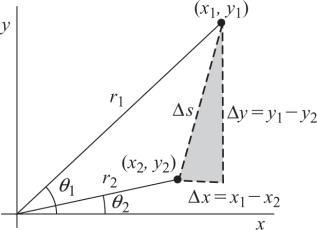
The distance between the two points is the length of the hypotenuse of the shaded triangle and is given by
Applying the identities cos2 + sin2 = 1 and cos 1 cos
2 + sin
1
2 = cos(1 2), this reduces to
1.45 (a) With a = 6.00 m and b being two sides of this right triangle having hypotenuse c = 9.00 m, the Pythagorean theorem gives the unknown side as b = c

(b) tanq= a b = 6.00 m 6.71m = 0.894
(c) sinf= b c = 6.71m 9.00 m = 0.746
1.46 From the diagram, cos(75.0) = d/L
Thus, d = L cos(75.0) = (9.00 m) cos(75.0) = 2.33 m

Topic 1 © 2025 Cengage Learning. All Rights Reserved. May not be scanned, copied or duplicated, or posted to a publicly accessible website, in whole or in part.
Topic 1
1.47 The circumference of the fountain is C = 2r, so the radius is r = C 2p = 15.0 m 2p = 2.39 m

Thus, tan(55.0°)= h r = h 2.39 m which gives
h = (2.39 m) tan (55.0) = 3.41 m.
1.48 (a) sinq= oppositeside hypotenuse so, opposite side = (3.00 m) sin (30.0) = 1.50 m (b) cosq= adjacentside hypotenuse so, adjacent side = (3.00 m) cos (30.0) = 2.60 m
1.49 (a) The side opposite = 3.00 (b) The side adjacent to = 3.00 (c) cosq= 4.00 5.00 = 0.800 (d) sinf= 4.00 5.00 = 0.800 (e) tanf= 4.00 3.00 = 1.33
1.50 Using the diagram below, the Pythagorean theorem yields c = (5.00 m)2 + (7.00 m)2 = 8.60 m
© 2025 Cengage Learning. All Rights Reserved. May not be scanned, copied or duplicated, or posted to a publicly accessible website, in whole or in part.
Topic 1
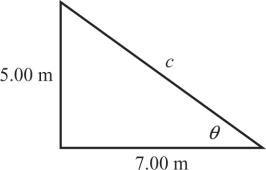
1.51 From the diagram given in Problem 1.50 above, it is seen that tanq= 5.00 7.00 = 0.714 and = tan 1 (0.714) = 35.5
1.52 Use the diagram below to equate two expressions for the mountain’s height (units and significant digits have been suppressed for clarity):

y = (x 1)tan(14.0) = (x)tan(12.0)
Solve for the unknown distance x to find
x -1 ( )tan 14.0° ( ) = xtan 12.0° ( ) x tan14° - tan12° ( ) = tan14° x = tan14° tan14° - tan12° = 6.78 km
Substitute the known value of x into y = (x)tan(12.0) to find the mountain’s height:
y = xtan 12° ( ) = 6.78 km ( )tan 12° ( ) = 1.44 km = 1.44 ´103 m
1.53 Using the sketch below:
© 2025 Cengage Learning. All Rights Reserved. May not be scanned, copied or duplicated, or posted to a publicly accessible website, in whole or in part.

1.54 (a) Using graphical methods, place the tail of vector at the head of vector . The new vector has a magnitude of 6.1 units at 113 from the positive x-axis. (b) The vector difference is found by placing the negative of vector (a vector of the same magnitude as , but opposite direction) at the head of vector . The resultant vector has magnitude 15 units at 23 from the positive x-axis.

1 © 2025 Cengage Learning. All Rights Reserved. May not be scanned, copied or duplicated, or posted to a publicly accessible website, in whole or in part.
1.55 We are given that . When two vectors are added graphically, the second vector is positioned with its tail at the tip of the first vector. The resultant then runs from the tail of the first vector to the tip of the second vector. In this case, vector will be positioned with its tail at the origin and its tip at the point (0, 29). The resultant is then drawn,
1
starting at the origin (tail of first vector) and going 14 units in the negative y-direction to the point (0, 14). The second vector, , must then start from the tip of at point (0, 29) and end on the tip of at point (0, 14) as shown in the sketch below. From this, it is seen that

1.56 (a) The distance d from A to C is where x = 200 km + (300 km)cos 30.0 = 460 km and y = 0 + (300 km)sin 30.0 = 150 km.

(b)
(c) Because of the curvature of the Earth, the plane doesn't travel
2025 Cengage Learning. All Rights Reserved. May not be scanned, copied or duplicated, or posted to a publicly accessible website, in whole or in part.
along straight lines. Thus, the answer computed above is only approximately correct.
1.57 (a) In your vector diagram, place the tail of vector at the tip of vector . The vector sum, , is then found as shown in the vector diagram and should be
(b) To find the vector difference , form the vector (same magnitude as , opposite direction) and add it to vector as shown in the diagram. You should find that
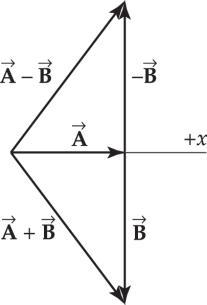
1.58 Find the resultant graphically by placing the tail of at the head of in a scale drawing as shown below. The resultant is the vector drawn from the tail of to the head of to close up the triangle. Measuring the length and orientation of this vector shows
© 2025 Cengage Learning. All Rights Reserved. May not be scanned, copied or duplicated, or posted to a publicly accessible website, in whole or in part.
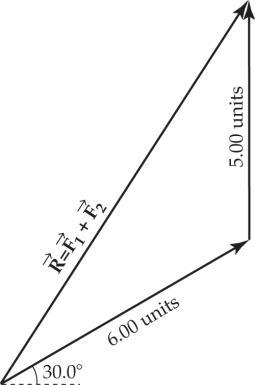
1.59 Your sketch should be drawn to scale, and be similar to that pictured below. The length of and the angle can be measured to find, with use of your scale factor, the magnitude and direction of the resultant displacement. The result should be approximately 421 ft 3 below the horizontal

1.60 (a) The x-component is x = (24.0 m)cos(56.0) = 13.4 m (b) The y-component is y = (24.0 m)sin(56.0) = 19.9 m
1.61 (a) The vector’s magnitude is
1 © 2025 Cengage Learning. All Rights Reserved. May not be scanned, copied or duplicated, or posted to a publicly accessible website, in whole or in part.
(b) The vector is in the second quadrant so its direction is
1.62 The person undergoes a displacement
Choose a coordinate system with origin at the starting point, positive x-direction oriented eastward, and positive y-direction oriented northward.
Then the components of her displacement are Ax = A cos = (3.10 km)cos 25.0 = 2.81 km eastward and Ay = A sin = (3.10 km)sin 25.0 = 1.31 km northward
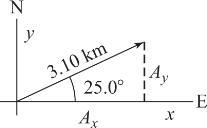
1.63 The x- and y-components of vector are its projections on lines parallel to the x- and y-axes, respectively, as shown in the sketch. The magnitude of these components can be computed using the sine and cosine functions as shown below:
© 2025 Cengage Learning. All Rights Reserved. May not be scanned, copied or duplicated, or posted to a publicly accessible website, in whole or in part.
1.64
1

(a) The skater’s displacement vector, , extends in a straight line from her starting point A to the end point B. When she has coasted half way around a circular path as shown in the sketch below, the displacement vector coincides with the diameter of the circle and has magnitude

(b) The actual distance skated, s, is one half the circumference of the circular path of radius r. Thus .
(c) When the skater skates all the way around the circular path, her end point, B, coincides with the start point, A. Thus, the displacement vector has zero length, or
2025 Cengage Learning. All Rights Reserved. May not be scanned, copied or duplicated, or posted to a publicly accessible website, in whole or in part.
Topic 1
1.65 (a) Her net x (east-west) displacement is 3.00 + 0 + 6.00 = +3.00 blocks, while her net y (north-south) displacement is 0 + 4.00 + 0 = +4.00 blocks. The magnitude of the resultant displacement is and the angle the resultant makes with the x-axis (eastward direction) is
The resultant displacement is then 5.00 blocks at 53.1 N of E
(b) The total distance traveled is 3.00 + 4.00 + 6.00 = 13.0 blocks
1.66 Let the positive x-direction be upfield. After the dribble, sideways run, and upfield pass, the football’s change in position, r , has components
dribblesidewayspass 10.0yd0yd50.0yd40.0yd xxxx =++=−++= and
dribblesidewayspass 0yd15yd0yd15.0yd. yyyy =++=++=
The football’s distance from its original location is then ( ) ( ) ( ) ( ) 222240.0yd15.0yd42.7yd rxy =+=+=
1.67 Ax = 25.0 Ay = 40.0
© 2025 Cengage Learning. All Rights Reserved. May not be scanned, copied or duplicated, or posted to a publicly accessible website, in whole or in part.
Topic 1
From the triangle, we find that , so = 180 = 122
Thus,
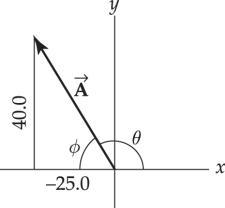
1.68 The displacement from Gwanju to Seoul ( )GS r equals the vector sum of the other two displacements: GSGDDS=+ rrr where GD r is the displacement from Gwanju to Daegu and DS r is the displacement from Daegu to Seoul. Taking the positive x- and y-directions to the right and up as usual, the components of GS r are ( ) ( ) ( )
GSGDDS 155kmcos22.5203kmcos9036.023.9km xxx =+=++= and ( ) ( ) ( )
GSGDDS 155kmsin22.5203kmsin9036.0224km yyy =+=++=
Therefore, the displacement from Gwanju to Seoul has a magnitude of
© 2025 Cengage Learning. All Rights Reserved. May not be scanned, copied or duplicated, or posted to a publicly accessible website, in whole or in part.
Topic 1
( ) ( ) ( ) ( ) 2222
in the direction
1.69 After 3.00 h moving at 41.0 km/h, the hurricane is 123 km at 60.0 N of W from the island. In the next 1.50 h, it travels 37.5 km due north. The components of these two displacements are:
Displacement x-component (eastward) y-component (northward)
Therefore, the eye of the hurricane is now
1.70 (a) F1 = 120 N
F1x = (120 N)cos 60.0 = 60.0 N
F1y = (120 N)sin 60.0 = 104 N
© 2025 Cengage Learning. All Rights Reserved. May not be scanned, copied or duplicated, or posted to a publicly accessible website, in whole or in part.
F2 = 80.0 N
F2x = (80 N)cos 75.0 = 20.7 N
F2y = (80.0 N)sin 75.0 = 77.3 N and
The resultant force is
(b) To have zero net force on the mule, the resultant above must be cancelled by a force equal in magnitude and oppositely directed.
Thus, the required force is 185 N at 258 from the x-axis
1.71 The components of the displacements , , and are
ax = a cos 30.0 = +152 km
bx = b cos 110 = 51.3 km
cx = c cos 180 = 190 km and ay = a sin 30.0 = +87.5 km
by = b sin 110 = +141 km
cy = c sin 180 = 0
Thus, Rx = ax + bx + cx = 89.3 km, and Ry = ay + by + cy = 229 km
Topic 1 © 2025 Cengage Learning. All Rights Reserved. May not be scanned, copied or duplicated, or posted to a publicly accessible website, in whole or in part.
so , and City C is 246 km at 21.3 W of N from the starting point.
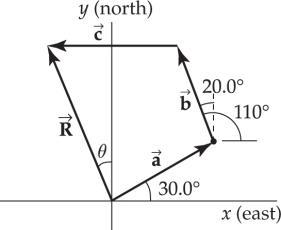
1.72 (a) 1 mi h = 1 mi h æ è
1.609 km 1mi
1.73 The term s has dimensions of L, a has dimensions of LT 2, and t has dimensions of T. Therefore, the equation, s = kam tn with k being dimensionless, has dimensions of L = (LT 2)m (T)n or L1T0 = Lm Tn 2m The powers of L and T must be the same on each side of the equation. Therefore, L1 = Lm and m = 1 Likewise, equating powers of T, we see that n 2m = 0, or n = 2m = 2
© 2025 Cengage Learning. All Rights Reserved. May not be scanned, copied or duplicated, or posted to a publicly accessible website, in whole or in part.
Dimensional analysis cannot determine the value of k, a dimensionless constant.
1.74 (a) The rate of filling in gallons per second is
= 30.0gal
(b) Note that 1m3 = (10
1min
1.75 The volume of paint used is given by V = Ah, where A is the area covered and h is the thickness of the layer. Thus, h = V A = 3.79
1.76 (a) For a sphere, A = 4R2. In this case, the radius of the second sphere is twice that of the first, or R2 = 2R1
Hence, A2 A1 = 4pR2 2 4pR1 2 = R2 2 R1 2 = (2 R1)2 R1 2 = 4 (b) For a sphere, the volume is V = 4 3 pR3
1 © 2025 Cengage Learning. All Rights Reserved. May not be scanned, copied or duplicated, or posted to a publicly accessible website, in whole or in part.
1.77 Assume N cars each drive an average of D km/yr with a fuel consumption of C L/(100 km). The total fuel consumed each year is then F = NDC and the change in F due to a change in average fuel consumption is ΔF = ND(ΔC). The fuel savings per year is the magnitude of ΔF so that ( ) ( ) 6 10 fuelsaved1yr
1.79 (a) The Sun’s radius is about 6.96 105 km and Earth’s radius is about 6.38 103 km. The number of Earths that could fit inside the Sun, NES, is approximately equal to the ratio of the Sun’s volume to Earth’s volume:
The Sun’s radius is about 102 times Earth’s radius, so its volume (which scales as radius cubed) is about 106 times Earth’s volume.
Approximately a million Earths could fit inside the Sun. (b) Similarly, the Moon’s radius is about 1.74 103 km so that NME, the number of Moons that could fit inside the Earth, is
© 2025 Cengage Learning. All Rights Reserved. May not be scanned, copied or duplicated, or posted to a publicly accessible website, in whole or in part.
Approximately 50 Moons could fit inside the Earth.
1.80 Assume a sneeze lasts about 3 seconds. One day equals 8.64 104 s which can be divided into 8.64/3 104 = 2.88 104 3-second intervals. If each of Earth’s 7.3 billion people sneezes 3 times per day, then 3(7.3 billion) = 21.9 billion sneezes occur each day. The number of sneezes occurring during any particular 3-second interval is then (rounded to 1 significant figure):
21.9 ´109 sneezes/ day 2.88 ´104 (3-sec intervals)/ day » 1´106 sneezes/ (3-sec interval)
During any given 3-second interval, approximately one million people from around the world will sneeze.
1.81 The volume of the Milky Way galaxy is roughly
If, within the Milky Way galaxy, there is typically one neutron star in a spherical volume of radius r = 3 1018 m, then the galactic volume per neutron star is
The order of magnitude of the number of neutron stars in the Milky
Way is then
1 © 2025 Cengage Learning. All Rights Reserved. May not be scanned, copied or duplicated, or posted to a publicly accessible website, in whole or in part.
